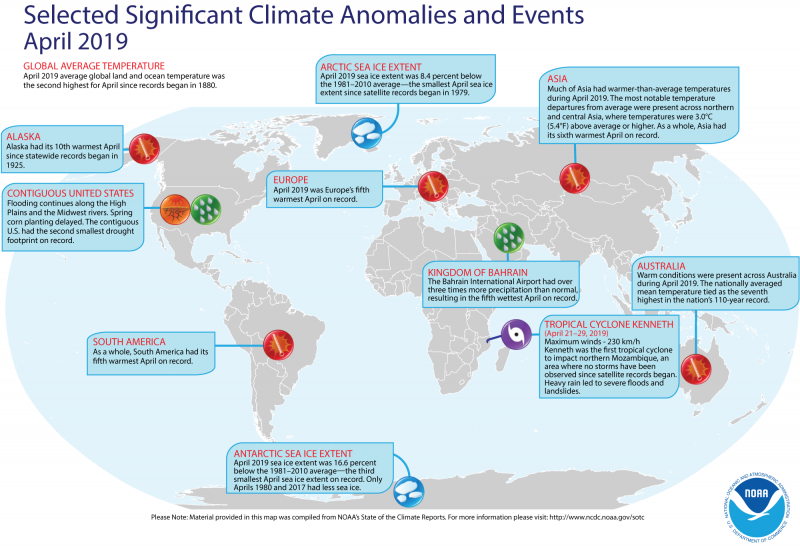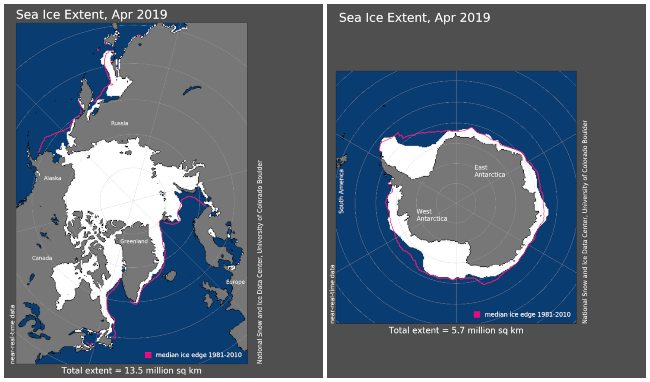

View larger. | An annotated map of the world showing notable climate events that occurred in April 2019. Image via NOAA.
Earth continues to warm, and last month was no exception.
Despite the cool springtime weather for some of us in the U.S., globally April 2019 was the second-hottest April in the climate record, dating back to 1880, according to NOAA’s April 2019 Global Climate Report. The Arctic region wasn’t spared either, as sea ice coverage shrank to a record low for the month.
The average global temperature in April was 1.67 degrees Fahrenheit (.9 degrees Celsius) above the 20th-century average of 56.7 degrees F (13.7 degrees C), making it the second-hottest April in the 140-year record, behind April 2016. Last month also was the 43rd consecutive April and 412th consecutive month that saw above-average global temperatures.

April 2019 marked the 18th consecutive April with Arctic sea ice extent below average. This was the smallest Arctic sea ice extent for April in the 41-year record at 8.4% below the 1981–2010 average and 89,000 square miles (230,500 sq km) below the previous record low set in April 2016, according to an analysis by the National Snow and Ice Data Center using data from NOAA and NASA. Image via NOAA.
Here are some highlights from NOAA’s latest monthly global climate report (read the full report here):
The period from January through April produced a global temperature 1.62 degrees F (.9 degrees C) above the average of 54.8 degrees F (12.7 degrees C), which is the third-hottest year-to-date on record. The record-warm temperatures for the four-month period were registered in parts of Australia, southeastern Brazil, central Asia, the southern Atlantic and southwestern Indian oceans and the Barents, East China and Tasman seas.
Sea ice shrank markedly at both poles: Average Arctic sea ice coverage (extent) in April was 8.4 percent below the 1981-2010 average – the lowest for April on record. The Antarctic sea ice extent was 16.6 percent below average, the third smallest for April on record.
Canadian coolness reached southward: Cooler-than-average temperatures were logged from January through April across much of Canada and the north-central U.S., about 3.6 degrees F (2 degrees C) below average.
March 2019 was also the 2nd hottest March on record for the globe.
Bottom line: NOAA reports that April 2019 was the second-hottest April on record. In the Arctic, sea ice coverage shrank to a record low for the month. The period from January through April was the thirrd-hottest year-to-date on record.
from EarthSky http://bit.ly/2I5avhA


View larger. | An annotated map of the world showing notable climate events that occurred in April 2019. Image via NOAA.
Earth continues to warm, and last month was no exception.
Despite the cool springtime weather for some of us in the U.S., globally April 2019 was the second-hottest April in the climate record, dating back to 1880, according to NOAA’s April 2019 Global Climate Report. The Arctic region wasn’t spared either, as sea ice coverage shrank to a record low for the month.
The average global temperature in April was 1.67 degrees Fahrenheit (.9 degrees Celsius) above the 20th-century average of 56.7 degrees F (13.7 degrees C), making it the second-hottest April in the 140-year record, behind April 2016. Last month also was the 43rd consecutive April and 412th consecutive month that saw above-average global temperatures.

April 2019 marked the 18th consecutive April with Arctic sea ice extent below average. This was the smallest Arctic sea ice extent for April in the 41-year record at 8.4% below the 1981–2010 average and 89,000 square miles (230,500 sq km) below the previous record low set in April 2016, according to an analysis by the National Snow and Ice Data Center using data from NOAA and NASA. Image via NOAA.
Here are some highlights from NOAA’s latest monthly global climate report (read the full report here):
The period from January through April produced a global temperature 1.62 degrees F (.9 degrees C) above the average of 54.8 degrees F (12.7 degrees C), which is the third-hottest year-to-date on record. The record-warm temperatures for the four-month period were registered in parts of Australia, southeastern Brazil, central Asia, the southern Atlantic and southwestern Indian oceans and the Barents, East China and Tasman seas.
Sea ice shrank markedly at both poles: Average Arctic sea ice coverage (extent) in April was 8.4 percent below the 1981-2010 average – the lowest for April on record. The Antarctic sea ice extent was 16.6 percent below average, the third smallest for April on record.
Canadian coolness reached southward: Cooler-than-average temperatures were logged from January through April across much of Canada and the north-central U.S., about 3.6 degrees F (2 degrees C) below average.
March 2019 was also the 2nd hottest March on record for the globe.
Bottom line: NOAA reports that April 2019 was the second-hottest April on record. In the Arctic, sea ice coverage shrank to a record low for the month. The period from January through April was the thirrd-hottest year-to-date on record.
from EarthSky http://bit.ly/2I5avhA

Aucun commentaire:
Enregistrer un commentaire